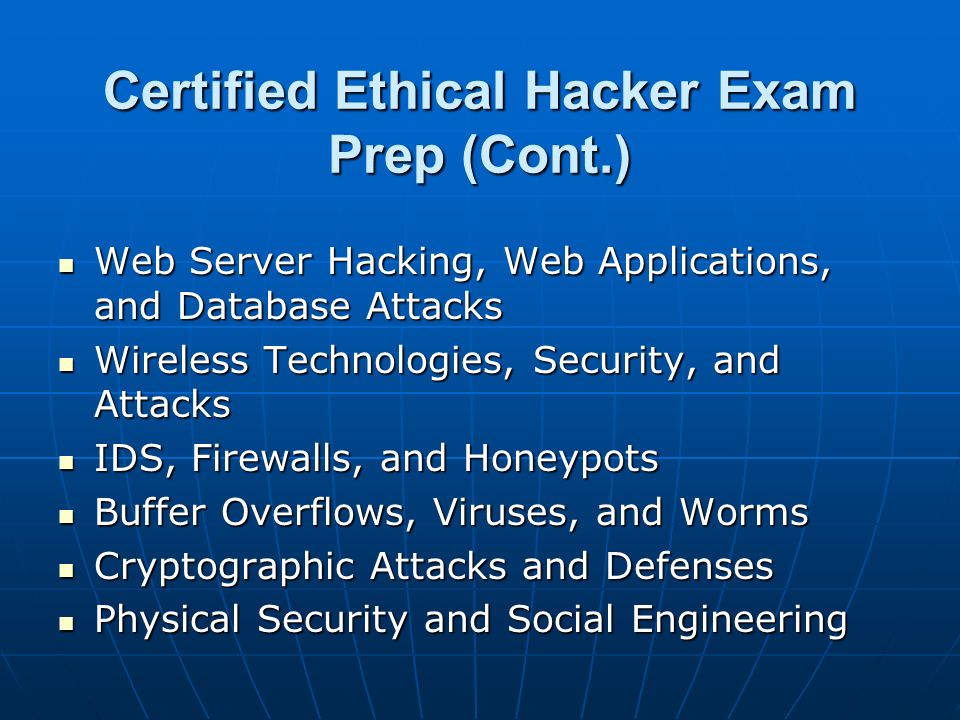
Difference Between Hacking And Ethical Hacking Ppt Presentation
• Threat: An environment or situation that could lead to a potential breach of security. • Exploit: A piece of software or technology that takes advantage of a bug, glitch, or vulnerability, leading to unauthorized access, privilege escalation, or denial of service on a computer system. • Vulnerability: The existence of a software flaw, logic design, or implementation error.
Sertifikat na tolj tg 350 1. Izaberite sistem Dodatni proizvodi SikaLastic®-1K Jednokomponentni, fleksibilni cementni malter za hidroizolaciju, ojačan vlaknima Fleksibilni malter za. Post on 15-Jul-2015. Category: Documents. Ekonomija ekologija ISSN br UDC List Saveza energeti~ara Broj 1-2 / Godina X / Mart 2006.
Ethical Hacking Overview. Describe the role of an ethical hacker; Describe what you can do legally as an ethical hacker; Describe what you cannot do as an.
• Target of Evaluation (TOE): A system, program, or network that is the subject of a security analysis or attack. • Attack: An attack occurs when a system is compromised based on a vulnerability.
• Remote: The exploit is sent over a network without any prior access to the vulnerable system. • The ethical hacker must follow certain rules: • Gain authorization from the client and have a signed contract giving the tester permission to perform the test. • Maintain and follow a nondisclosure agreement (NDA) with the client in the case of confidential information disclosed during the test.
• Maintain confidentiality when performing the test. • Information gathered may contain sensitive information. No information about the test or company confidential data should ever be disclosed to a third party. • This phase involves a formal agreement between the ethical hacker and the organization. This agreement should include the full scope of the test, the types of attacks (inside or outside) to be used, and the testing types. • Conduct Security Evaluation • During this phase, the tests are conducted, after which the tester prepares a formal report of vulnerabilities and other findings. • Conclusion • The findings are presented to the organization in this phase, along with any recommendations to improve security.

In This Chapter • The Difference Between Hackers and Crackers • Tools of the Trade • Exploits and the SANS Top 20 The purpose of this chapter is to illustrate the methodology and steps ahacker or cracker employs when attacking a network. It also provides an overviewof the System Administration Network Security (SANS) Top 20 vulnerabilities thatcrackers can exploit. The Difference Between Hackers and Crackers To understand the methodology of a hacker or cracker, one must understandwhat a hacker or a cracker is. Internet enthusiasts have argued the differencebetween hackers and crackers for many years. This chapter contains mycontribution to that debate.
If I were forced to define the terms hacker and cracker, mybottom line would probably be this: • A hacker is a person intensely interested in the arcane andrecondite workings of any computer operating system. Hackers are most oftenprogrammers. As such, hackers obtain advanced knowledge of operating systems andprogramming languages. They might discover holes within systems and the reasonsfor such holes. Hackers constantly seek further knowledge, freely share whatthey have discovered, and never intentionally damage data.
• A cracker is one who breaks into or otherwise violates the systemintegrity of remote machines with malicious intent. Having gained unauthorizedaccess, crackers destroy vital data, deny legitimate users service, or causeproblems for their targets. Crackers can easily be identified because theiractions are malicious. Additionally, it should be mentioned that there are two major types ofcrackers.